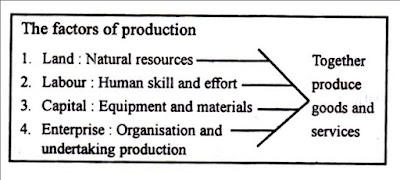google.com, pub-3084614342339514, DIRECT, f08c47fec0942fa0
UGC NET ,UPSC and other Competitive exams FACTOR Value (MICROECONOMICS )
 |
| Factor Value |
Variables of creation can be characterized as sources of info utilized for delivering merchandise or administrations with the expect to make financial benefit.
In financial matters, there are four principle variables of creation, in particular land, work, capital, and endeavor. The value that a business visionary pays for profiting the administrations of these elements is called factor estimating.
A business person pays lease, wages, intrigue, and benefit for profiting the administrations of land, work, capital, and undertaking individually. The hypothesis of factor estimating manages the value assurance of various components of creation.
The assurance of factor costs is constantly thought to be like the assurance of item costs. This is on the grounds that in both the cases, the costs are resolved with the assistance of interest and supply powers. Besides, the interest for variables of creation is like the interest for items.
Notwithstanding, there are two fundamental contrasts on the inventory side of components of creation and items. Right off the bat, in item showcase, the stockpile of an item is dictated by its negligible expense of creation. Then again, in factor advertise, it is unimaginable to expect to decide the inventory of elements based on minor expense.
Model,
it is hard to determine the specific expense of creation for factors, for example, land and capital. Besides, the inventory of components of creation can't be promptly balanced as on account of items. For example, on the off chance that the interest for a land builds, at that point it is beyond the realm of imagination to expect to expand its stock right away.
Idea of Factor Valuing:
Factor valuing is related with the costs that a business person pays to benefit the administrations rendered by the elements of creation. For instance, a business person needs to pay wages to work, rents for benefiting area, and premiums for capital with the goal that he/she can gain most extreme benefit. These elements of creation straightforwardly influence the creation procedure of an association.
In setting of an economy, these four variables of creation when joined together produce a net total of items, which is named as national pay. In this manner, it is essential to decide the costs of these four variables of creation. The hypothesis of factor valuing manages the assurance of the offer costs of four components of creation, specifically land, work, capital and venture.
As such, the hypothesis of factor evaluating is worried about the standards as per which the cost of each factor of creation is resolved and disseminated. In this manner, the hypothesis of factor valuing is otherwise called hypothesis of dispersion. As indicated by Chapman, the hypothesis of dispersion, "represents the sharing of the riches delivered by a network among the specialists, or the proprietors of the operators, which have been dynamic in its creation."
There are two parts of each factor of creation, which are as per the following:
I. Value Angle:
Alludes to the angle where an association pays a specific add up to benefit the administrations of variables of creation. For instance, wages, leases, and interests comprise the cost of variables of creation.
ii. Pay Viewpoint:
Alludes to another viewpoint where a specific sum is gotten by a factor of creation. For example, rents got by a proprietor and wages got by work comprise the salary created from the components of creation.
For the most part, it is accepted that factor evaluating hypothesis is like item estimating hypothesis. Be that as it may, there are sure contrasts between the two speculations. Both the speculations accept the assurance of costs by the cooperation of two market powers, to be specific interest and supply.
In any case, there are contrasts in the idea of interest and supply of elements of creation regarding that of items. The interest for elements of creation is determined interest, while interest for items is immediate interest. In addition, the interest for the components of creation is joint interest.
This is on the grounds that an item can't be delivered utilizing a solitary factor of creation. Then again, the stock of items is firmly related with the expense of creation, though there is no expense of creation for factors. For instance, there is no expense of creation for land, work, and capital. Subsequently, the factor valuing is isolated from item estimating.
Hypotheses of Factor Valuing:
The hypothesis of factor valuing is worried about the standards as indicated by which the cost of each factor of creation is resolved and circulated. The circulation of variables of creation can be of two sorts, to be specific individual and useful. Individual dispersion is worried about the circulation of salary among various people.
It is related with the measure of pay produced not with the wellspring of pay. For instance, an individual procures Rs. 20,000 every month; this pay can be earned by him/her by wages, rents, or profits. Then again, utilitarian dissemination is related with the conveyance of salary among various elements of creation according to their capacities.
It is worried about the wellspring of pay, for example, compensation, leases, interests, and benefits. In respect of circulation of variables of creation, there are two hypotheses, specifically minimal profitability hypothesis and current hypothesis of factor estimating.
The accompanying focuses feature the best highlights of factor estimating. The highlights are: 1. Inferred Request 2. Joint Interest 3. Troubles in Changing Element Supply 4. No Full Command Over the Factor Supply.
Highlights of Factor valuing
Highlight 1.
Inferred Request:
It is seen that the interest for a factor, in contrast to the interest for a product, is an inferred request. It implies that the interest for any factor of creation relies upon the presence of an interest for the merchandise that it assists with making. Along these lines the interest for PC programmers or television repairers is developing, as an ever increasing number of electronic PCs or Televisions are utilized. The interest for school instructors increments at whatever point the quantity of understudies in universities increments.
Highlight 2
Joint Interest:
The interest for a factor of creation is basically an instance of joint interest. It implies that as one specific factor can't deliver anything, practically all the elements are requested mutually and at once to create a specific thing. In any case, the products are not mutually requested aside from on account of some unique merchandise like bread and butter or elastic stamp and stamp-cushion, and so forth.
Highlight 3.
Challenges in Changing Component Supply:
The inventory of a factor has a few characteristics. The inventory of a large portion of the merchandise can, when all is said in done be expanded or diminished by their interest or costs. An ascent in the cost of an item would urge the makers to deliver and supply business as usual.
Be that as it may, any expansion in factor cost, for example, lease or compensation doesn't achieve an increment in the stock of land at all or a prompt increment in the stockpile of work even. Likewise, a fall in the cost of a ware by and large realizes a fall in its stockpile, yet this isn't so on account of land or work or some other factor.
Highlight 4.
No Full Authority Over the Factor Supply:
It is additionally watched the proprietors of elements don't have full command over the conditions which decide factor supply. In this manner the stockpile of cash capital depends in enormous measure on the nation's national salary, peace circumstance, banking framework and so forth. The providers of capital or savers don't have any command over these' conditions. In any case, this trademark isn't typically found on account of the stockpile of merchandise.






Comments
Post a Comment